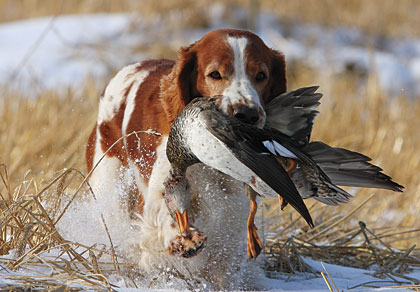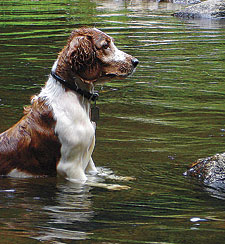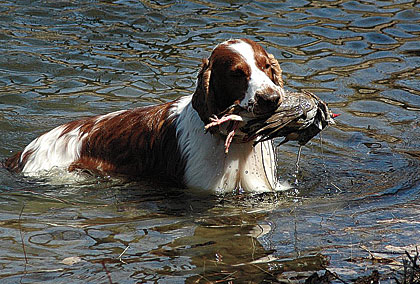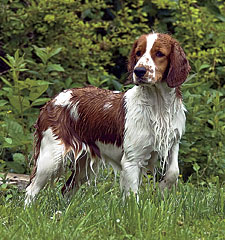The little-known Welsh springer is still a capable hunter.
By M.J. Nelson
 UH SHR Ch Greenwood's Angus MH WDX CGC, Brian Schmidt's WSS, will diligently work out the trail of any bird. Here, Angus reaps the reward for his efforts. |
In 2008, the American Kennel Club reported that exactly 240 Welsh springer spaniels were registered. This means that in the sporting breed spaniel "subgroup," only the American water spaniel and the field spaniel were fewer in number. (Irish water spaniels also rank lower on the AKC's popularity list, but the IWS is considered to be a retriever and is ineligible to compete in spaniel field events.)
In addition to being uncommon, the Welsh springer is often mistaken for a Brittany. Both are medium-sized sporting dogs and have similar colors, with the Welshie being red and white and Brits coming in orange and white. However, one of my orange and white Brits was so dark that had the standard not specified the correct color term as "orange," her predominant color could easily have been mistaken for red.
Indeed, the two breeds may spring from a common ancestor. A white hunting dog with red markings was brought to Wales by the Gauls, a Celtic people who lived in an area bordered on the south by the Pyrenees Mountains and on the east by the Rhine River (present-day France, Belgium, Luxembourg and portions of the Netherlands and Germany) as well as Great Britain, in about 250 BC. But the Welsh springer people contend that somewhere along the line, the Brittany went astray, most likely from all that high living on the Continent.
Instead of charging in and putting the birds to wing for their guns, as any self-respecting spaniel would do, the effete Brit was stopping and pointing birds. To the rough-hewn Welshmen, this was like making sure you had the proper crook to your pinky when you sipped tea from a bone china cup.
There is also the matter of ears, the old Welsh bird hunters snorted. The Welsh spaniel, as the breed was originally called, had good, solid spaniel ears, while the decadent Bretons' dog had a short, triangular "hoity-toity" ear.
 This Welshie clearly isn't reluctant to take a dip in the water--a trait that lends the WSS the willingness to take on just about any retrieve. |
But the isolation of Wales, which was perfect for the development of the Welsh springer, also meant that the breed seldom appeared outside the borders of this small nation, which is about the size of New Jersey. This gave the English springer spaniel a huge jump in popularity as a gun dog long before anyone outside of Wales knew there was another "springer." The disparity in numbers continues in the modern era with 6,690 English springers registered in 2009.
While the ESS is vastly more popular, there are reasons aplenty to hunt with a Welshie, not the least of which is that they hunt at a slower pace than does the ESS, and they have fewer health and temperament problems.
"We had three English springers before we got our first Welshie," says Peggy Ruble, who, with her husband, Bill, has owned Welsh springers for nearly 25 years. "We had problems with the temperament and the health of each one of these dogs. I met a Welshie at a dog show and loved both the look and temperament of the dog.
"Bill needed a hunting dog, and I wanted one that would be competitive in the show ring and also do obedience. One of the nice things about this breed is that unlike the English springers, there's no split between 'show' and 'field' types. Many of the Welshies that have hunt test titles are also conformation champions."
 Ch. Ky-Bryn Frontline Gunner CDX SH RA CGC VCX, one of Bill and Peggy Ruble's Welshies, is the best of both worlds in Peggy's view--a pretty dog that hunts. Gunner is a "meat-on-the-table" hunting dog. |
For Brian Schmidt, who owns UH SHR Ch Greenwood's Angus MH WDX CGC, the move to a Welsh springer was dictated by a change in his hunting. "I used to own a Brittany when I hunted upland birds a lot. But now that I'm primarily a waterfowl hunter, I needed a dog that liked the water and had a strong desire to retrieve," Schmidt says. "But I also needed a dog that I could take with me in my canoe or kayak without tipping it, and still have some room for decoys.
"Plus, I wanted a dog that hunted at a slower pace than an English springer, would have the kind of disposition to be relaxed in the house and in a blind, but still be able to turn on its drive in the field. I also wanted a dog that would work with me, not necessarily for me, or like a robot.
"Within reason, a WSS can do it all. Angus performs well as a non-slip retriever for mourning doves all the way to Canada geese. He can handle a variety of upland game, pheasants, grouse and quail, in a variety of habitats. We've even run the marshes for snipe and rails. I'm sure he'd be an excellent squirrel dog, also, if his success in the backyard is any indication."
This is a true "meat-on-the-table" hunting dog, according to Ruble. "They have excellent noses, and they are very good at tracking cripples. You seldom lose a downed bird when you hunt with a Welshie," she notes. "They are also endurance dogs. They pace themselves, and they hunt all day long. They are smart hunters and don't waste energy.
"They have one other attribute that I love. When hunting season rolls around, you don't have to spend time retraining a Welshie. They retain what they learn. On the other hand, this is not a dog to send to a trainer. They need to be trained by their owners because they will work for the person they are devoted to. They make lousy outdoor dogs because they want to be in the middle of everything the family does."
Schmidt also cited the breed's scenting ability. "I have both judged and trained several different spaniels but the WSS stands out in its ability to work out scent," he says. "Most will run a quartering pattern like the ESS or an English cocker, but their action
s are more deliberate and thorough. When they acquire a scent, the WSS will diligently work out the trail to the bird. Although they work at a slower pace than an ESS or ECS, they have the ability to turn on speed when they need to chase down game.
"As far as I can see, the only drawback to hunting with the WSS is they don't tolerate the cold water late in the waterfowl season very well. They are good swimmers, but you can't expect them to perform like a Labrador. If you hunt waterfowl in the late season, you need to exercise caution if you are hunting with a WSS.
"They are also what I'd call 'Velcro dogs.' They want to be with you everywhere, and they stay nearby. This works to your advantage when hunting upland birds with them, as they usually flush game well within gun range. But it can be a problem when you want them to make 100-yard or longer blind retrieves. Of course, this can be overcome with training and experience."
Ruble notes that this breed can be slow to mature. "They need training early in their lives or they may become self-hunters," she cautions. "On the other hand, they need ample time to mature, as they are slow to grow up, so patience is needed. It is easy to ruin a Welshie with poor training methods. They will quit on you if they are pushed too fast or treated harshly.
"They can also be noise-sensitive, so introduction to the gun needs to be done carefully. Welshies are on the soft side. They do not respond well to heavy-handed or unclear training methods. They do respond well to praise and encouragement. They can be hard to fine-tune, as they do not see a need to repeat drills, which makes it difficult to perfect any aspect of their training."
 Make no mistake: This is no Brittany. But Welshies are considered just as versatile a breed, with both upland and water proficiency. |
As is frequently the case with rare breeds, one of the biggest challenges for anyone who wants to own a Welsh springer is finding one. Because the gene pool is so small, it is important to exercise caution when you do go looking for a WSS. As is the case with many purebred sporting breeds, the WSS can have health issues, including hip and elbow dysplasia, epilepsy, thyroid disease and some eye problems.
"You need to look for a breeder that does health checks and offers proof of the results," says Ruble. "The Welsh Springer Spaniel Club of American has a breeder referral on its Web site (www.wssca.com) that lists breeders in various regions of the country who are in good standing with the club and have been for at least two years.
"It is also important to find a dog from a breeder who hunts or a litter whose sire and dam hunt. I look for pups from breeders who both show and hunt with their dogs because the dog's conformation is important. It determines how effective the dog will be in the field.
"Besides, you get the best of both worlds. You get a dog that's pretty and hunts. However, you may have a considerable wait for a pup, as finding a dog that meets the breed standard and has a biddable temperament, good health and exhibits strong hunting instincts can be a challenge."






